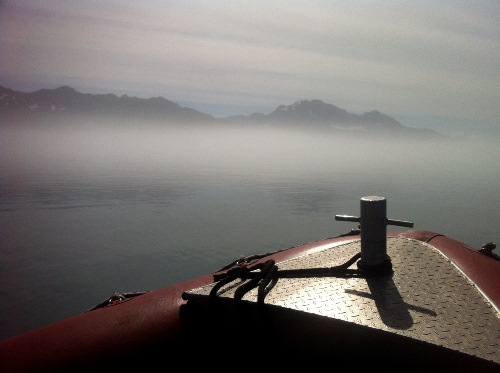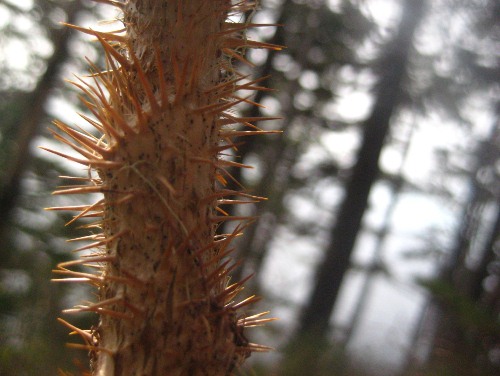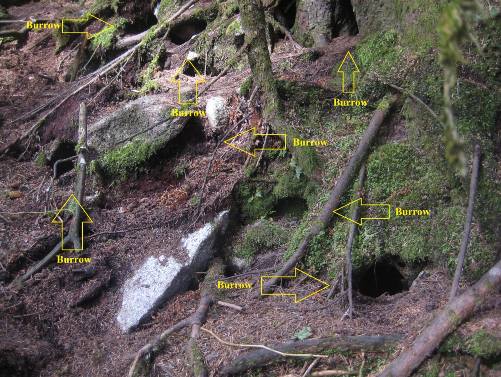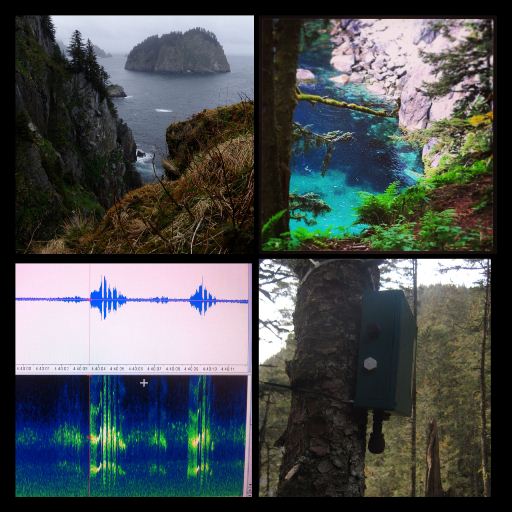We watch the swell rise and fall as we inch closer to the looming mountain of Matushka. The steep Chiswell Islands jut out of the Gulf of Alaska in the Alaska National Maritime Wildlife Refuge (ANMWR). The heaving of the waves comes in steady increments; the menacing larger sets make my heart quicken. I take a deep breathe, rehearsing the landing in my mind.
"Slow is pro," I assure Jen Curl, my field partner, a graduate student and boat driver extraordinaire. She carefully positions the bow of our 16-foot Naiad, in a delicate dance with the surge. Landing here is not an easy undertaking. I sit tensely ready on the steel bow, with a white-knuckle grip on the vessel's cross-shaped Samson post. Jen edges us close enough so that I can leap onto the rocky shore without involuntarily swimming in the frigid water or smashing our boat onto the jagged barnacle-encrusted rocks. Although both scenarios seem likely, with our experience, skill, and maybe a bit of luck, the drop-off is successful.

The Samson post on the steel bow of the Naiad headed into the field on a misty morning. Photo: NPS \ Elisa Weiss
"You okay?!" Jen yells over the crashing surf and straining boat engine.
"I'm good!" I shout and find my footing among intertidal creatures and algae. I clamber up the island's steep perimeter, shed my cumbersome float coat and perform a quick radio check.
My route up to the top of the island isn't so much a hike, but a forest climb. I use my arms to pull myself up over mossy boulders and around fallen trees. I weave through salmonberry bushes and carefully tip-toe around the infamously evil devil's club. With each step I hope the soil is solid enough to support me as I galumph over boulders and embrace soggy logs, taking tree-hugging to a whole new level.

Devil's Club (Oplopanax horridus) is notorious for being a very wrong choice of a hand hold. Photo: NPS \ Elisa Weiss
After coating myself in woody debris (and pioneering a new sport of forest climbing), I reach an area almost devoid of ground vegetation. At first glance, it seems like easy walking but look closer and you'll find the ground is perforated with burrows, hundreds and hundreds of burrows.
Welcome to Burrow City.

Welcome to Burrow City: please tread lightly. An "apartment complex" of Burrow City on Matushka Island. Photo: NPS \ Elisa Weiss
A clear line of sight makes unsuspecting hikers feel as if they could easily run through unscathed. The seabird burrows act as land mines for punching through the soft dirt at the perfect depth for spraining ankles. As biologists, we hope not to harm species in our work environment (including ourselves). Avoiding crushing the burrows requires a bit of finesse, jumping from each piece of stable ground to the next.
The top of the island drops off the other side into a sheer cliff. Wind whips up almost 1000 feet from the crashing waves below. The sounds of seabirds calling reverberates off of the cliff walls. The beauty of it all distracts me from the task at hand: to deploy a bioacoustic recording device called a Song Meter to confirm what species of seabirds are burrow-nesters here. I find a tree in close proximity to an area abundant with burrows and then zip tie the Song Meter to a branch, (a very technical procedure). The Song Meter will record for 9 hours each night: 2 hours before sunset and 2 hours after sunrise for several weeks.

Different perspectives of Matushka Island (starting left to clockwise): looking east from the top of Matushka towards Beehive Island, the view for the residents of Burrow City on the west side of the island, the Song Meter zip tied to a tree, and a spectrogram of fork-tailed storm petrel's call. Photos: NPS \ Elisa Weiss
I leave the Song Meter to brave the wind and cold and descend back through the forest to the shoreline, where I make it safely back on the boat.
After one additional deployment, at the end of the field season we retrieve the Song Meter. Like us, the Song Meter must make a quick transition from the wilderness back to the confines of civilization. I download the data as audio files back at the office. Using bioacoustics software provided by the Cornell UniversityLab of Ornithology called RavenLite, I am able to listen to the files and see a visual representation of the sounds as a spectrogram.
In collaboration with ANMWR, this is the second year of a pilot study to see what burrow-nesting seabird species inhabit Matushka Island. We have discovered an active breeding colony of fork-tailed storm petrels and rhinoceros auklets (the noisy, nocturnal tenants of Burrow City). We also heard bald eagles, peregrine falcons, ravens, glaucous-winged gulls, songbirds and parakeet auklets during the wee hours of dawn and twilight.
This bioacoustic monitoring is an excellent method for tracing seabird populations. It is an opportunity to listen to untainted sounds of nature over extended periods without impacting wildlife with human presence. Through the darkness of night, we hope these recordings will collectively shed light on the health of seabird populations in the near future.
Not to mention, it's always an adventure to visit Matushka Island.
To listen to recordings of the Fork-Tailed Storm Petrel and Rhinoceros Auklet, visit http://youtu.be/S7H3rWSICLY.
